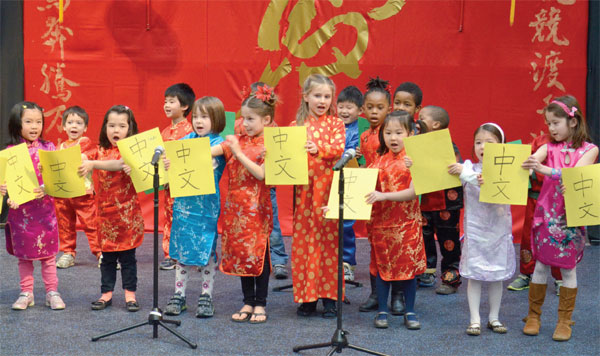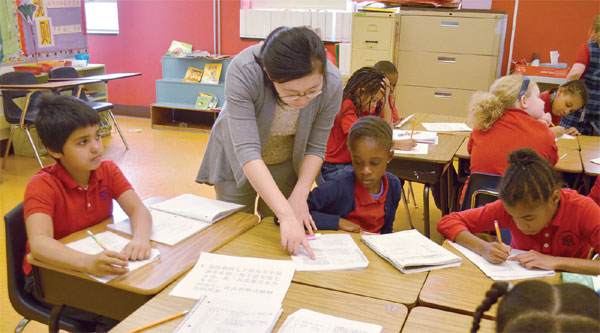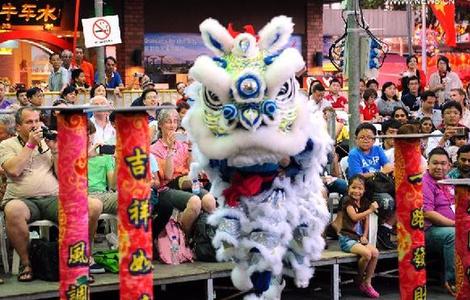Start it early, start it full
Updated: 2015-02-20 10:49
By Cai Chunying(China Daily USA)
|
||||||||
They are so popular that some US schools have used lotteries to determine who gets enrolled. "They" are Chinese immersion programs, which integrate teaching Chinese into everyday curriculum, CAI CHUNYING reports from Washington.
With Chinese Lunar New Year on Thursday, Aniya Carrington is busy perfecting singing a Chinese song that she will perform with her classmates at her school to celebrate the Year of the Ram.
The 6th-grader at Baltimore International Academy, a K-8 public charter school, recently also helped a Chinese woman who could not speak English at an emergency room to communicate with nurses and doctors during a visit to the place by Aniya with her family.
|
Students from the Chinese immersion program at the College Garden Elementary School perform in Chinese the song I Love Chinese during a Chinese New Year celebration event at Lakeforest Mall in Gaithersburg, Maryland, last February. Cai Chunying / China Daily |
|
Teacher Xiao Chen helps a student practice math concepts and questions taught in Chinese at a 3rd grade Chinese immersion class at Baltimore International Academy in January. Cai Chunying / China Daily |
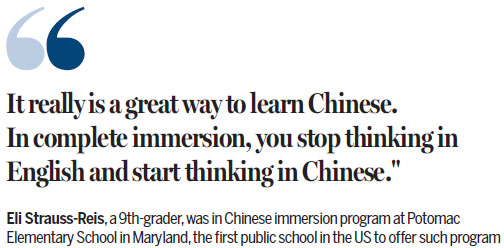
Aniya, who has been studying Chinese since kindergarten, is among more than 20,000 students in the United States enrolled in an increasingly popular program: Chinese immersion.
Similar to the immersion program of other languages such as French and Spanish, Chinese immersion programs use Chinese (mostly Mandarin) to teach subjects such as math, science and social studies. Through the process, students not only learn their subjects but acquire the language at a relatively proficient level.
In 2000 there were only nine elementary and secondary public and private schools in the US offering Chinese immersion programs. The number of programs exploded after 2007, with an annual average increase of 18. And now there are 187 elementary and secondary schools in 27 US states and the District of Columbia (DC) offering Chinese immersion programs, with most at K-5 level, according to the Mandarin Immersion Parents Council, a non-profit organization which tracks the number of such programs.
The programs have become so popular that many schools run a lottery for enrollment.
For example, Washington's Yu Ying Public Charter School, the only Chinese immersion school in DC, which US First Lady Michelle Obama visited and was impressed before her trip to China last May, had more than 1,000 applicants for about 20 open slots for the academic year 2014-2015.
Language immersion is not foreign to human learning. All children grow up learning their native language through immersing in the spoken environment provided by their parents and communities. Research shows that immersion is one of the most effective ways to learn a language.
Eli Strauss-Reis, now a 9th-grader, started Mandarin immersion in kindergarten at Potomac Elementary School, the first public school in the US to offer such a program in 1996, all the way through 5th grade. He has kept studying the language in middle and high school.
"It really is a great way to learn Chinese. In complete immersion, you stop thinking in English and start thinking in Chinese," he told China Daily in an interview that started in Chinese with near-native fluency. "You are not only studying the language, you are using the language on a daily basis. It's a lot fun as well. You learn it naturally so you do not need to sit there writing it or memorizing it."
Why Chinese immersion?
Myriam Met helped to launch the program at Potomac Elementary School while serving as coordinator of foreign language for Montgomery County Public School in Maryland. Being very much involved in Spanish and French immersion programs in other districts before, Met applied for a similar one in Asian languages upon learning the US government has grants to encourage such projects.
"It is up to the school and parents' choice to select which Asian language to study and they picked Chinese for they think it is the language of 21st century," said Met who later became the acting director of National Foreign Language Center and a sought-after expert in the immersion field.
The program proved to be very popular among parents so the county, answering a parents' petition, started another one at College Garden Elementary School in 2005.
Washington's Yu Ying school, however, did not start its immersion program with such ease.
When Mary Shaffner's daughter reached near-school age in DC, she found no school offered a Chinese-language learning class, so she gathered support from 10 like-minded parents, who all have personal connections with China, to launch a public charter Chinese immersion school from scratch, which is open to all children in the city.
Shaffner, who studied Chinese and lived in China for a while, still remembers when the school petition reached the city's public charter school board's hearing in 2007 after an onerous preparation process.
"They looked at me and said, `Who wants to learn Chinese anyway?'" Schaffer recalled. "About 100 parents in the audience, all dressed in Yu Ying T-shirts, stood up and said 'We do'." The school was soon approved. Today it has become one of the "hottest" schools in DC.
Shaffner along with others launched a new middle and high school - District of Columbia International School - in 2014 so Yu Ying students can continue learning Chinese there upon graduation.
A beneficiary
Kona-Facia Nepay, founder of Baltimore International Academy (BIA) has a similar story. She herself is a beneficiary of a language immersion program. Nepay learned her French in immersion style in her native country Liberia, and the experience was so amazing to her that she later finished her graduate studies in France specializing in immersion teaching.
When she moved to Baltimore, Nepay wanted her son to study French but found no school offered it. Nepay and her husband gathered support from other parents and started BIA in 2007, offering four languages-Chinese, Spanish, French and Russian. The school added Arabic in last fall, becoming the only one in the nation offering immersion in five languages.
Nepay said Chinese immersion programs in the US have grown so rapidly that they have almost become "vogue". "It's now everywhere," she said. In recent years, BIA has had twice many applicants that it could accept for its Chinese immersion program.
For parents, believing in the power of foreign language and the advantage their children can gain in the global job market often plays a major role in their decision to choose Chinese immersion.
"Going to an early language immersion program gives them the opportunity to use the part of the brain that they otherwise will not use until later in life," said Miranda, the mother of Aniya.
Miranda said it was Aniya's father's decision to pick Chinese because he saw China as a rising power and has been seeing the need for people who can speak Chinese and the growth of Chinese language in the US.
Performance speaks
Even though in Chinese immersion classes many curricular subjects are taught in Chinese, students still need to take standard tests in English on various subjects set by the states.
For outsiders and new parents, it is often hard to imagine that an English-speaking student could master a subject that is taught in another language.
Research, however, has shown that students can indeed learn concepts in one language and then utilize them in another. A test score is one of the best proofs. According to Elizabeth Weise, author of A Parent's Guide to Mandarin Immersion, presumably the most resourceful book in the field, current data show that Chinese immersion students not only score as good as their peers in a regular English track, they often excel.
Interviews with administrators and teachers in the greater Washington area involved in Chinese immersion programs also suggest that this outcome is universal among their students.
"It is common for students to lag a bit behind their peers for the first a couple of years while they are grasping the basic concepts of language and subjects. They, however, do catch up steadily and often surpass their peers in later years, rather noticeably," said Zhian Zhang, Chinese immersion program director at Potomac Elementary School, which has both English-track class and Chinese immersion class throughout K-5 levels.
Research shows that immersing in a foreign language stimulates the brain, improves attention, enhances self control and the ability to deal with complex information, leading to better academic performance.
But Myriam Met, the immersion expert, believes the main reason may be teaching.
"In order for an immersion teacher to be effective with students learning the language, they have to use a lot of teaching strategies that I think in the long run are simply good teaching," said Met.
Airry Zhang, Chinese immersion program director at BIA who also teaches kindergarten, agrees. She said their teachers have to work particularly hard to convert the required concepts and skills in the common English curriculum to Chinese and then search for the best way to teach it. Jingmei Shi, an assistant teacher in Zhang's class and a former university teacher in China, believes that the enthusiasm she has seen among her students is mainly due to how they are taught the language and content.
Nepay, founder of BIA, praised the nine teachers in her Chinese immersion program as extremely committed. "We found the culture of Chinese people lend themselves to hard work and commitment. Our colleagues in Chinese immersion program are very cohesive, cooperative. They are team players. They always do things together and they do it so excellently," she said.
Do they really learn Chinese?
Do students really acquire Chinese at proficiency level at the end of their several years' commitment?
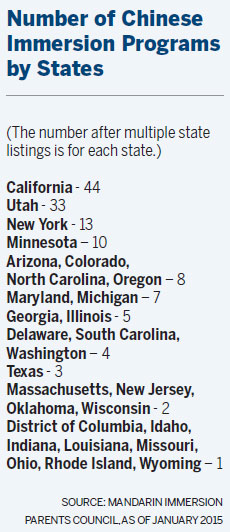
Chinese is not an easy language to learn for English speakers. Unlike French or Spanish, there are no words in Chinese and English that share similar meaning, spelling or pronunciation.
The US State Department's Foreign Services Institute, which trains American diplomats, classifies Chinese as a Category III language which requires a native English speaker on average 88 weeks of full-time effort to achieve general proficiency, while French and Spanish only require 24 weeks.
Bethanie Weitz, Chinese immersion program coordinator at College Garden Elementary School in Maryland, and Potomac Elementary School's Zhang both said students' listening ability can often achieve native-like levels while their speaking and writing skills usually lag a bit behind. Due to their daily practicing the language in academic content instead of a real life setting, their social vocabulary in Chinese is not as rich as some would hope. And this often is the nature of an immersion program for any language.
But even with this limit, the language ability that students gain in an immersion program is much better than if they have just a one-hour daily Chinese language lesson.
"Children are more successful than anybody ever would believe what's possible," said Met, who now works as consultant for various academic entities and immersion programs. "They really acquire the language and are able to communicate it. We are still working on some of the best ways to teach and some of the best materials we can use. We just want to be even more successful than we are now."
Parents are often a very important part of that success. Choosing a Chinese immersion program often means extra work at home to keep children on track.
"I know going to an immersion program is a sacrifice for us. We, however, feel very strongly about school and our involvement. So, taking on that responsibility is something we already know we are going to do," said Miranda, mother of Aniya.
"It does require a lot of involvement from the parents. It was a big part of my kids growing up," said Kit, mother of Eli. She said when Eli was little, she would only hire baby-sitters who spoke Chinese or Spanish. She played Chinese TV at home and put on Chinese-language audios or videos when driving the children in the car.
Kit also has sent Eli and his brothers to a Chinese immersion camp run by Concordia Language Village in Minnesota almost every summer. Eli also went to Middlebury College, a renowned language-teaching school in Vermont, for its program for high school children. She also hired private tutors to help Eli.
"If you want your kids to really speak the language well, you really need to do something outside of the program," she said.
Eli still learns Chinese at his high school with a one-hour Chinese lesson every day. He said the majority of students who started with him in kindergarten are still actively learning Chinese. Many of them went to China in 5th grade on a trip organized by the school.
Although Eli hasn't decided what he wants to do in the future, he said that he envisions a career in which Chinese will be a very active part of his job. "I will be very disappointed if I do not do that," he said. "I really enjoy using it and I really enjoy going to China."
What Miranda says she enjoys the most is when she and her two daughters participate in Chinese cultural events, using what they have learned.
"The kids were really involved. They looked for ways to get out there to showcase that there is this school and they are growing and learning and doing well. All the parents were amazed when seeing them. It is a beautiful thing," said Miranda.
Major events
With continuing cultural exchanges among the US and China and a large Chinese-American population in the greater Washington area, the school has had many opportunities to be part of some major events, including welcoming Chinese president Hu Jintao's state visit to the US in 2011.
"Learning about another culture helps them to appreciate not just other culture, but their own. They are more aware that people are different and can embrace a variety of cultures and religions, it really broadens their minds," Miranda said.
Nepay, the BIA founder, said this kind of extracurricular event really motivate her students and is a very important part of what makes the Chinese immersion program at her school special. "Now other programs were motivated to reach out and do the same," she said.
Miranda is already thinking about how to keep up Aniya's learning Chinese after graduating from BIA. She said the program has opened up so many possibilities for her daughters.
"You do not have to be doctors or veterinarians. You can be an ambassador, a mediator, an interpreter. This just opens up a whole world that is not available for me when I grew up," she said. "I look back and think about being so nervous sending her (to the school), and I looked at them growing and blossoming, I am so glad that we took the chance."
Contact the writer at charlenecai@chinadailyusa.com
(China Daily USA 02/20/2015 page20)
Most Viewed
Editor's Picks

|

|

|

|

|

|
Today's Top News
California port chief optimistic on new labor agreement
NBA China CEO sees the sport proliferate
China tilts to Kabul with US pullout
No letup seen for business travel
Chinese visitors set to celebrate New Year worldwide
China No 1 dumper of plastic into ocean
Chinese students gather in Washington
Upbeat on US-China relations
US Weekly

|

|
